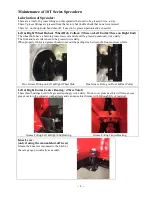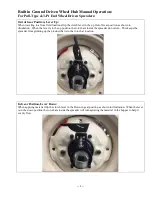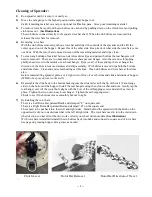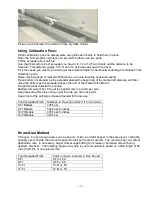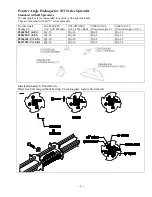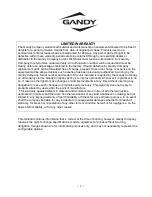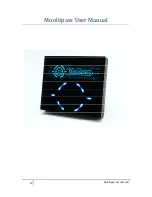
~
1
~
Picture of a Calibration Pan Held in Place By Sash Chains
Using Calibration Pans:
Place calibrations pans on spread-plate using the sash chains to hold them in place.
Note: the 6-ft spreader only uses one pan all the others use two pans.
Fill the spreader about half full.
See chart below for size of spreader you have 6, 8, 10 or 12-Ft and mark out the distance to be
traveled. This distance equals 1/10 of an acre at the speed you with to travel.
Pick the speed you what to go and travel the distance listed in chart below collecting the material in the
calibration pans.
Begin moving ahead of marked off distance so you are traveling at desired speed.
Open bottom of spreader as the spreader passed the beginning of the marked off distance and then
close the bottom as the spreader passes the end of the marked off distance.
Weight material collected in pounds.
Multiply this weight by 10 to get the applied rate in pounds per acre.
Keep repeating this step until you get the rate you are looking for.
Keep tract of the setting and speed traveled for future use.
Your Spreader Width
Distance to Travel to Collect 1/10 of an Acre.
6-Ft Models
726 Feet
8-Ft Models
544 Feet, 6-inches
10-Ft Models
435 Feet, 8-inches
12-Ft Models
363 Feet
Know Area Method
Fill hoper. Treat a known area, such as an acre or two, and refill hopper to the same level, noting the
quantity used. Divide the amount required to refill by the area covered. The result will be your actual
application rate. In necessary, adjust Cam-Gauge setting to increase or decrease amount being
applied. Recheck. The following figures may help in your computations based on a filed length of 80
rods (1320-Ft), or one-quarter mile.
Your Spreader Width
Portion of Acre Covered in One Round
6-Ft
6-Ft or .38
8-Ft
8-Ft or .50
10-Ft
10-Ft or .63
12-Ft
12-Ft or .75
Содержание 10-Ft
Страница 2: ......



